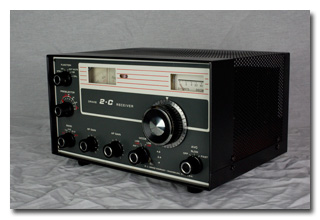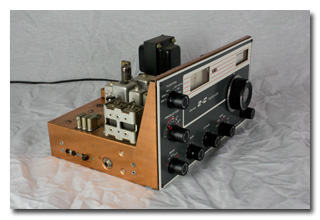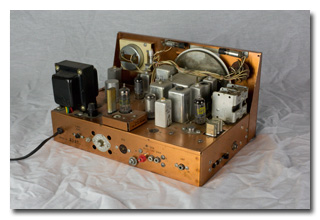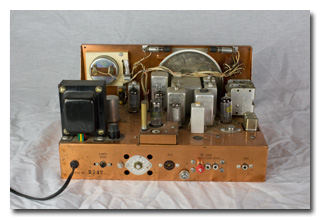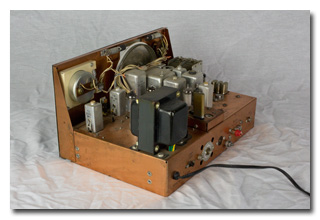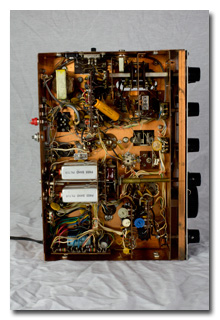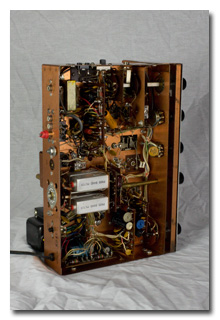
by William Eric McFadden
From the manual:
-
The 2-C Receiver is an extremely versatile communications receiver designed for reception of upper and lower single-sideband, CW or AM signals between 3.0 and 30 MHz.The receiver coverage is in 5 bands. With crystals furnished, coverage of the amateur bands of 80 meters (3.5 - 4.0 MHz), 40 meters (7.0 - 7.5 MHz), 20 meters (14.0 - 14.5 MHz), 15 meters (21.0 - 21.5 MHz), and the 28.5 to 29 MHz portion of 10 meters is provided. Accessory crystals provide 500 KHz incremental coverage from 3.0 to 30 MHz.
SPECIFICATIONS: Mode of Operation SSB, CW, AM, RTTY Selectivity Selectable passband filter provides: .4 KHz at 6 DB down and 2.7 KHz at 60DB down. 2.4 KHz at 6 DB down and 9.0 KHz at 60DB down. 4.8 KHz at 6 DB down and 16.8 KHz at 60DB down. Selectivity switching is independent of detector and AVC switching. Stability Less than 100 Hz after warm up. Less than 100 Hz for 10% line voltage change. Sensitivity Less than .5 uV for 10DB signal plus noise to noise on all amateur bands. Dial Calibration Main dial calibration 0 to 500 KHz in 10 KHz divisions. Vernier dial calibrated in approximately 1 KHz divisions. Both main dial and vernier are adjustable for calibration purposes. AVC Amplified delayed AVC having slow (.75 sec.) or fast (.025 sec.) discharge and less than 100 microsecond charge. AVC can also be switched off. Less than 6 DB audio change for 100 DB RF input change. Audio Output 1.8 watts with less than 5% distortion and .75 watts at AVC threshold. Hum Level Greater then 60 DB below rated output. Audio Output Impedence 4 ohms Antenna Input Nominal 52 ohms. Spurious Responses Image rejection greater then 60 DB; IF rejection greater than 60 DB on ham bands; internal spurious signals within ham bands less than the equivalent 1 uv signal on the antenna. Power Consumption 30 watts, 120 VAC, 50/60 Hz Size 11-5/16 inches wide 6-9/32 inches high 9-3/23 inches deep Weight 13-1/2 pounds TUBES AND SEMI-CONDUCTORS TUBES FUNCTION 12BZ6 1 R.F. Amplifier 12AU6 1st Mixer 12BE6 VFO Controlled 2nd Mixer 12BE6 3rd Mixer 12BA6 50 KHz IP Amplifier 12BA6 50 KHz IP Amplifier SEMI-CONDUCTORS FUNCTION 2N3394 Crystal Oscillator 2N3877 AGC Amplifier 2N3394 50 KHz Oscillator (2) 1N270 Product Detector 1N270 and 2N3394 AM Detector and Amplifier (2) 2N3394 Audio Amplifier 40310 (RCA) Audio Output (2) 1N3194 Hi voltage Rectifier (2) 1N3194 Lo voltage Rectifier 1N3194 Bias Rectifier 1 At some point, R.L. Drake started using the 6-volt 6BZ6 as the R.F. Amplifier tube.
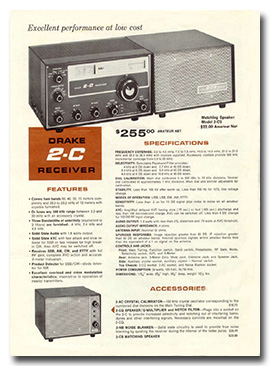 The 2-C receiver was offered by the R.L. Drake Company of Miamisburg, Ohio from 1966 through 1974.
The 2-C receiver is a vacuum tube (five) and semiconductor (fourteen) hybrid design which offers
receive-coverage of the pre-WARC amateur bands between 3 MHz and 30 MHz (80, 40, 20, 15,
and 10m) in USB, LSB, CW, and AM modes.
The 2-C receiver was offered by the R.L. Drake Company of Miamisburg, Ohio from 1966 through 1974.
The 2-C receiver is a vacuum tube (five) and semiconductor (fourteen) hybrid design which offers
receive-coverage of the pre-WARC amateur bands between 3 MHz and 30 MHz (80, 40, 20, 15,
and 10m) in USB, LSB, CW, and AM modes.
I acquired my very clean Drake 2-C at the 2016 Athens Hamfest. Except for slightly dirty switch contacts and potentiometers and loose-fitting RCA sockets on the back, the receiver worked very well upon initial power-up. Application of DeOxit to the switches, pots, and sockets and very slight re-shaping of the RCA sockets restored the receiver to proper operation. The inside of the receiver is clean but no so clean as to indicate this receiver has been restored although I suspect the black cabinet has been repainted. My 2-C has the optional 2-AC internal crystal calibrator but lacks the optional 2-NB noise blanker. The serial number, 2947, indicates my 2-C was manufactured in early 1971 (source). My 2-C is new enough to have been manufactured with the 6BZ6 tube as the R.F. Amplifier instead of the original 12BZ6.
The seller at the Athens Hamfest had taken this 2-C and a matching 2-CQ speaker / q-multiplier to the hamfest intending to sell them as a set. However, by the time I found the seller's table, he had already sold the 2-CQ separately. I looked for a 2-CQ at the 2016 and 2017 Hamventions and at smaller hamfests but found none.
Thanks to the kind generosity of KG9EE, I acquired my very clean 2-CQ in late 2017. In addition to looking very fine sitting next to the 2-C receiver, the speaker's audio is very good and the notch and peak functions are very effective. Surprisingly, even without the q-multiplier functionality engaged, the audio from the 2-C through the 2-CQ is much more pleasant than the 2-C audio was through the Radio Shack Minimus 7 speaker I had pressed into service before getting the 2-CQ. When using the the Minimus 7, I had to ride the 2-C's RF-gain control to prevent overload. With the 2-CQ, I can leave the RF-gain control fully clockwise without any problem. I suspect the mismatch between the Minimus 7's 8Ω input-impedence and the 2-C's 4Ω output-impedence was too much for the 2-C's audio-output circuitry but I wonder if the Minimus 7 is also too efficient for the 2-C.
I would like to find a 2-NB noise blanker module for my 2-C receiver but don't hold out much hope for success.
I've discovered what might be an undocumented "feature" of the 2-C receiver. If one selects the 40m band, turns the main tuning to "0", and peaks the Preselector near the 10m band, one can receive WWV / WWVH on 15MHz.
Photos
Drake 2-C Links
- Drake 2-C Receiver and 2-NT Transmitter, December, 1966 QST; members-only at ARRL
- 2-C Manual & Schematic at BAMA
- Drake Radios at Yahoo! Groups
Attributions:
- Drake 2-C Brochure found at WB4HFN's Drake Page
